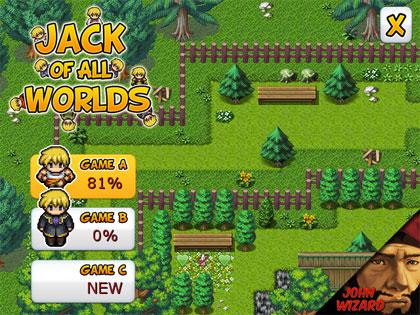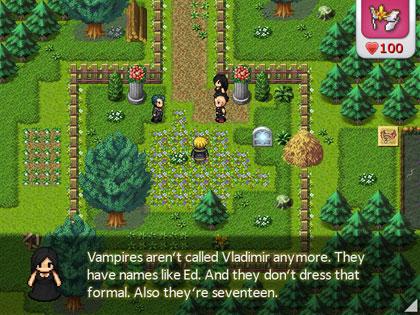- Wondering how to get Monopoly GO! free rolls? Well, you’ve come to the right place. In this guide, we provide you with a bunch of tips and tricks to get some free rolls for the hit new mobile game. We’ll …
Best Roblox Horror Games to Play Right Now – Updated Weekly
By Adele Wilson
Our Best Roblox Horror Games guide features the scariest and most creative experiences to play right now on the platform!The BEST Roblox Games of The Week – Games You Need To Play!
By Sho Roberts
Our feature shares our pick for the Best Roblox Games of the week! With our feature, we guarantee you'll find something new to play!Type Soul Clan Rarity Guide – All Legendary And Common Clans Listed!
By Nathan Ball
Wondering what your odds of rolling a particular Clan are? Wonder no more, with my handy Type Soul Clan Rarity guide.
Jack of All Worlds Review
John Wizard’s latest RPG is a bit of a misfire. Jack of All Worlds sports the developers’ trademark witty dialogue and strong production values, but it also has a peculiar, memory-based battle system, precious little in the way of character development, a hero we never really get to know, and an abrupt and unsatisfying ending.

Jack of All Worlds
John Wizard’s latest RPG is a bit of a misfire. Jack of All Worlds sports the developers’ trademark witty dialogue and strong production values, but it also has a peculiar, memory-based battle system, precious little in the way of character development, a hero we never really get to know, and an abrupt and unsatisfying ending.
The game begins with our protagonist, a kid named Jack, witnessing the accidental death of his father. A spirit appears and offers him the chance to bring his dad back to life. The catch is that he has to visit several other worlds and right their wrongs by inhabiting the bodies of local citizens embroiled in important conflicts. Think Quantum Leap, but with fuzzier plotlines and characters that are never fully explored. Few details about the people we inhabit are provided, and we always jump back to the hub world without being shown the consequences of our actions.

These narrative issues might be forgivable had a richer portrait been painted of our hero, Jack. We know nothing about him and are provided only brief glimpses of his thoughts. It would have been easier to sympathize had we been given deeper monologues showing him to be conflicted over what he has to do to save his father and angrier about the mysterious and seemingly immoral orders he receives from the spirit. As is, he blindly stumbles from one world to the next and we along with him.
A saving grace comes in the form of John Wizard’s typically excellent dialogue. The game starts with some obvious references to Stephanie Meyer’s Twilight books as we visit a vampire world in which characters named Ed and Bell apparently plan to take down an old-school, tux-wearing bloodsucker named Ivan because they think vamps ought to be young, cool, and not derive from Transylvania. Even more amusing is an Australia-inspired world filled with dialogue thick with down under-isms in which the player must perform tasks such as hunting down a baby stolen by a dingo.
But while the game’s activities are often wittily framed, they’re usually much too simple to offer any real gratification. Short term goals consist of working through a few screens to find a key, sword, or a lever, then heading back to use it in the appropriate location. Even simpler quests involve fetching items and delivering messages.
Luckily, Jack’s primary objectives are a little more involved. Our main mission in each world is to find a mask. A skull mask allows Jack to toss a rope over a wooden stump and use it to cross rivers and ascend buildings; a cat mask lets him destroy blue crystals that block paths; and a black shadow mask allows him to see invisible bridges.
There are eight masks in all. Using them is probably the most rewarding part of the game. There are plenty of areas containing important items that we can’t get to until we have the right mask. Going back to retrieve these items once we have the proper mask scratches a loose-end itch that slowly builds throughout the game. In fact, going back and finding all of the game’s world-specific items—each level contains 80 items of a certain type, such as scrolls, gems, or boots, that must be found in order to access the game’s final scene—is probably the most satisfying and challenging thing players will do.

It’s certainly more challenging than battling the game’s snakes, guards, and assorted monsters.
Fights consist of memorizing your enemy’s attacks. With each turn, enemies hit Jack between three and five times in a color-coded pattern that has to be repeated by the player. Repeat the pattern correctly and you can choose a special attack of your own to cause massive damage. You’ll never have to do it more than three or four times to defeat an enemy (there are no bosses).
Over the course of the game’s eight or nine hours I failed to match my enemy’s attack patterns exactly five times—and only then because my wife called my attention away from the screen, causing me to miss the pattern. Put another way, the battles are extremely easy and repetitive.
They also offer little in the way of motivation. Some enemies carry important items you’ll need to collect. Other than that, there’s no reason to attack them. Our hero doesn’t earn experience, level up, or find any new armour, weapons, or magical spells in battle. The only way he grows as a character is by collecting shields and swords lying on the ground. These items ostensibly make him more powerful, but since enemies grow in strength as the game progresses it never feels as though Jack gets any stronger than he is at the game’s outset.
John Wizard deserves some credit for thinking outside the box on this one, but Jack of All Worlds lacks the thoughtful consideration put into the developer’s previous titles. This game is short, laughably easy, and shallow. It’s not a total wash—some of the dialogue is very funny, and the masks’ powers can be quite gratifying—but it’s definitely a disappointment.

The good

The bad
More articles...
Monopoly GO! Free Rolls – Links For Free Dice
By Glen Fox
Wondering how to get Monopoly GO! free rolls? Well, you’ve come to the right place. In this guide, we provide you with a bunch of tips and tricks to get some free rolls for the hit new mobile game. We’ll …Best Roblox Horror Games to Play Right Now – Updated Weekly
By Adele Wilson
Our Best Roblox Horror Games guide features the scariest and most creative experiences to play right now on the platform!The BEST Roblox Games of The Week – Games You Need To Play!
By Sho Roberts
Our feature shares our pick for the Best Roblox Games of the week! With our feature, we guarantee you'll find something new to play!Type Soul Clan Rarity Guide – All Legendary And Common Clans Listed!
By Nathan Ball
Wondering what your odds of rolling a particular Clan are? Wonder no more, with my handy Type Soul Clan Rarity guide.







